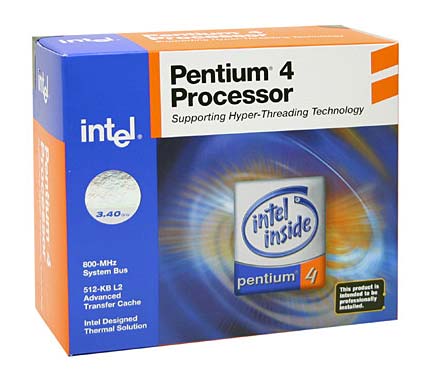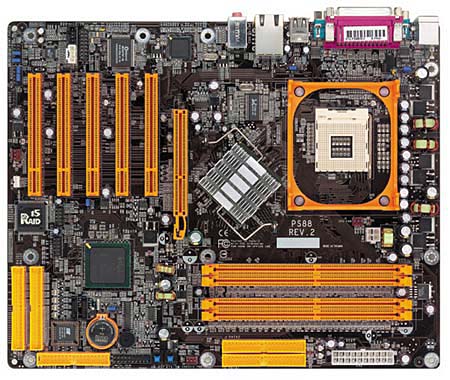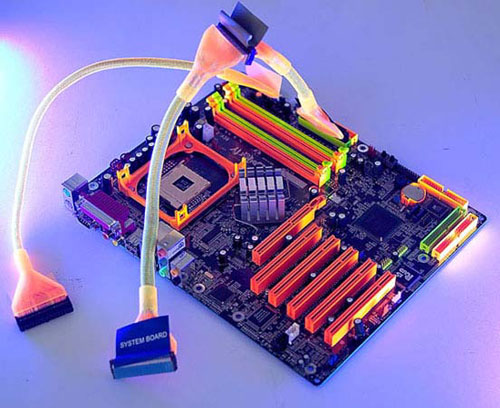Buyer's Guide: High End System - May 2004
by Wesley Fink on May 26, 2004 11:00 AM EST- Posted in
- Guides
CPU and Motherboard Alternatives
CPU: Intel Pentium 4 3.4C (512K L2 cache) NorthwoodMotherboard: DFI (875P chipset)
Price: CPU - $416 shipped (retail heatsink and fan). Motherboard - $174 shipped

Despite the fact that cost is a secondary concern in recommendations for a High End system, it is still difficult to recommend the $1100 3.4GHz Pentium4 EE when the 3.4GHz P4C (Northwood) is 60% less with the same core and 512KB cache instead of 2.5MB. 250% seems a hefty premium for the extra cache when the impact on performance is fairly small. If you want the bragging rights that come with the top Intel CPU, then get the P4EE, but the 3.4C is our recommendation at about the same price as the AMD Athlon 64 3400+. Both offer similar performance in today's applications depending on exactly which applications you use. For Desktop Applications, the 3.4C and 3400+ are virtually equal. If you do a lot of encoding, then the pendulum tilts toward the 3.4C over the 3400+ for now. If you're a gamer, the Athlon 64 3400+ is a better performer in most games. If 64-bit capabilities matter to you, then the AMD Athlon 64 is your only option. We suggest that you research which processor fits you best. A good place to start is at AnandTech's latest CPU article.
One advantage of a Pentium 4 is Hyper Threading, which makes a single processor behave like two multiple processors in some ways. Hyper Threading can increase performance substantially in multi-tasking situations, but the impact is less noticeable as clock speed increases. In today's applications, HT does not offer much benefit, though this may change in some future applications.
Intel seemed to design their labeling system to utterly confuse the buyer, so it is worth some efforts to clear the misunderstandings. An Intel Pentium 4 labeled with a "C" after its core clock speed (3.4C, in this case) is based on the Northwood core, has 512K of L2 cache, and is built on (mostly) 0.13-micron technology. A Pentium 4 labeled with an "E" after its core clock speed (3.4E for example) is based on the Prescott core, has 1MB of L2 cache, and is built on (mostly) 0.09-micron technology. Finally, a Pentium 4 labeled with an "EE" after its core clock speed (3.4EE, for example) is based on the Northwood core, has 512K of L2 cache plus 2MB of L3 cache, and is built on (mostly) 0.13-micron technology. The C, E, and EE Pentium 4 processors all run at 800MHz FSB and are dual channel DDR capable. While the future for Intel is slated to be the Prescott CPU, the slower speed and heat make the Prescott a difficult choice over the Northwood at current speeds. Performance becomes less an issue as speed increases and the heat issue is also improving. Next month's Socket 775 CPU from Intel will be Prescott-based and we have already seen that Prescott optimizations in the chipset can provide a big boost on Prescott Performance. The point here is this: Intel is constantly refining the Prescott, as they did with the original Pentium 4, so Prescott must be considered a work-in-progress that is getting better every day.
One of the most amazing turnarounds in the computer industry has been DFI. The large OEM partner decided to go after the enthusiast market with their own brand and transformed themselves from "Diamond Flower International" into "Designed For Innovation". It takes real performance to achieve this kind of transition and DFI has delivered this in spades in their LAN Party motherboard series.

The LAN Party 875B is an excellent and flexible home for a 3.4C, particularly in the latest Rev. B version. The Asus P4C800-E and DFI 875B LAN Party seems to make every recommended list as the top two motherboards for Intel enthusiasts because they are both solid performers at stock speeds and they both are capable of incredible performance with the fastest memory and Intel processors on the market. Our nod for top end system goes to the DFI because high end systems should stand out in some way, such as incredible performance or incredible looks. The DFI has both and you certainly will notice this motherboard as it is also unique to look at, particularly under black light. The 875B LAN Party also does the eye-candy trick without giving up anything in performance or flexibility.

While the price of the DFI is toward the high end, it includes matching glowing cables, a Front-X box for front ports, and a PC Transport to carry your PC. All these features would cost quite a bit extra if you had to buy them on the side, so there is definitely value in the DFI 875B. If the extras don't matter much to you, the same basic board is available as the DFI 875P Infinity for about $40 less. Revision B of the DFI has a greater range of adjustments than the original LAN Party and it also sports CMOS reloaded, a unique feature allowing several custom BIOS setups to be saved and selected in CMOS. All the top-end features are here with the notable exception of Firewire, so if you require Firewire, choose another board or add a Firewire PCI card. In addition to all the high-end goodies in the LAN Party box, there is an impressive feature list that includes Intel SATA RAID, Intel Gigabit CSA LAN, High Point 4-device IDE RAID supporting RAID 0, 1, 0+1, and 1.5 (a method to stripe and mirror using just 2 drives), 6-channel audio featuring the CMedia CMI9739A chip and a SPDIF IO bracket, and 8 USB 2.0 ports. End users who own the 875 LAN Party tell us that it is bullet-proof and one of the most stable motherboards they have ever owned - always a great recommendation for a high end motherboard.
Listed below is part of our RealTime pricing engine, which lists the lowest prices available on the Intel CPUs and motherboards from many different reputable vendors:
If you cannot find the lowest prices on the products that we've recommended on this page, it's because we don't list some of them in our RealTime pricing engine. Until we do, we suggest that you do an independent search online at the various vendors' web sites. Just pick and choose where you want to buy your products by looking for a vendor located under the "Vendor" heading.










59 Comments
View All Comments
ghoti - Wednesday, May 26, 2004 - link
Thanks for these Guides! I sure appreciate them.I'm about to build my first system.
Anyone know when the MSI K8N Socket 754 MB (mentioned in the Guide) will be available?
Also, assuming I get the MSI K8N, I plan to use the AMD 64 3200, and would like to put in 2GB(?) memory. Considering possible FUTURE use (in a dual channel application), I guess I'd get a PAIR of 1024's. In checking the MSI memory compatability table, I don't see anything I recognize. Do I need to worry about that? Can I just go ahead and get one of the highly-reviewed brands/ types (e.g., Mushkin Pro). I don't plan to OC, but considering possible FUTURE use in/ with some other MB/ processor, does it make sense to get a higher speed than PC3200?
Thanks for the input.
hifisoftware - Wednesday, May 26, 2004 - link
Good to hear about the changes, hopefuly giuides will even be better with more time dedicated to them.Great review, nice choices.
I would choose few componenets differently though:
1. Secondary choice for the HD. Samsung seems to be faster then Segate in real world benches (From xbitlabs testing). Segate is one of the worst performing brands in their tsting.
2. DVD I like NEC DVD writer more since it cost about the same (+/- few $), but there is a hack to convert it to double layer version.
Still a great guide, lots of usefull info. Cool
Ma10n3 - Wednesday, May 26, 2004 - link
For a total budget of $5,000 or less, why not opt for a mobo that can support two Opteron 250s, but only purchase one initially. The TYAN Thunder K8W supports AGP 8x/Pro, has 4 PCI-X slots (hardware RAID anybody?), and a legacy 32-bit/33MHz PCI slot. Also, the onboard gigabit ethernet chip is connected to the PCI-X bus... absolutely no bottlenecks there. And when the Windows 64-bit Home edition comes out you can slap in the second processor and 4 more DIMMS and effectively double your memory bandwidth, due to the NUMA support in Windows 64.My point is, if you're going to invest so much in a high-end system, why not make it as future-proof as possible by leaving open extreme expandability paths.
PCI-X rulez.
Zebo - Wednesday, May 26, 2004 - link
My bad wesley I was comparing the $404 Opteron 148 (2.2) to the $728 FX 51 (2.2). However I'm building this system with the $210 Opteron 144;) and hope to get the FX53 speeds for 1/4 the price....Wesley Fink - Wednesday, May 26, 2004 - link
#2 - The same speed Opteron is the 150 at 2.4GHz. It is a bit cheaper at $620 but it is hardly half the price. It is also multiplier locked where the FX is completely unlocked. If overclcoking is not important to you, then the Opteron 150 and 3200 Registered memory would be a good choice and save about $150 total.Your point about the Saphire Radeon 9800 PRO is well taken, and I have changed the Alternate to the 256-bit model, which I did find on Pricewatch for $192 shipped.
Zebo - Wednesday, May 26, 2004 - link
#1 I agree or go for one of LG/Philips's 20" 16ms IPS LCD branded by Dell, Viewsonic, NEC, amoung others. At around $700-$1200 it's pretty competitive.Azmedaj - Wednesday, May 26, 2004 - link
Typo on the storage page: "Those concerned about data security more than ultimate speed can configure the drives as RAID 0, or mirroring", it Should be Raid 1Zebo - Wednesday, May 26, 2004 - link
Opteron is half the price as FX and is the same but for top locked multiplier, but with that ram recommedation you can OC with ease, if that's a concern.Also 128MB Saphire Radeon 9800 PRO for $175 shipped is the 128bit verison aka LE, I would get the 256 for $209 shipped.
JGF - Wednesday, May 26, 2004 - link
I like everything except for the CRT monitor. I would swap the samsung out for a 21" mitsubishi diamond pro 2070 or the equivalent NEC model the FP2141SB.